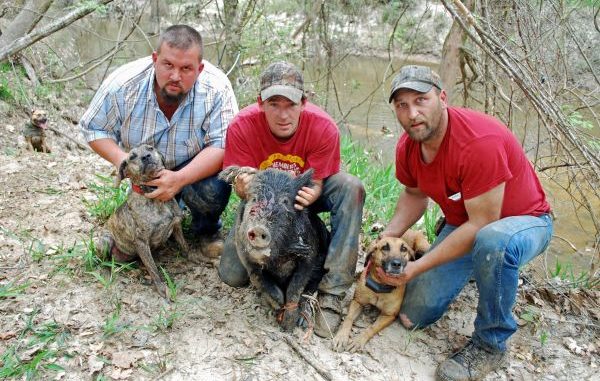
Feral hogs do have some friends, but they certainly aren’t located within the Louisiana Department of Wildlife and Fisheries.
Biologist Scott Durham, the agency’s deer study leader, called them an “ecological disaster.” Dr. James M. LaCour, the state wildlife veterinarian, agreed.
“Hogs are bad,” LaCour said. “They are fun to shoot and good to eat, but they are bad for the landscape and bad for other wildlife species.”
Durham, an 18-year veteran of the department and a deer hunter himself, said that where hogs are, deer aren’t.
“There is no social tolerance among white-tailed deer for hogs,” he said. “Hog presence is a stressor that is additive to other sources of stress on deer.”
Besides science, he pointed to his own hunting experiences.
“When I am on my stand and I see a herd of hogs, I won’t see a deer all day,” he said. “The next day a buck comes in upwind, where I know that he can’t smell me. When he gets to where the hogs were, the hog smell makes him act wild and incredibly nervous, and he will run away.”
Durham added that research shows deer sightings where hogs are present are reduced nearly 50 percent.
The recent explosion in Louisiana’s hog population has left Durham and LaCour gape-mouthed. Both men agreed that Louisiana has long had feral hogs, but their numbers were manageable and contained in a few areas — the Pearl River swamps, the Lake Catahoula area and the Sabine River bottoms.
“Now,” Durham said, “I can’t think of where they don’t occur.”
Last year, for the first time on record, Louisiana’s feral hog harvest was larger than its deer harvest: 161,000 hogs to 152,000 deer, numbers that he said were “pretty amazing.”
Much of the problem, the experts said, is that hogs are fun to hunt so hunters catch the animals, transport them to new areas and release them. LaCour is convinced such activities are the biggest factor in the spread of hogs to new areas.
Louisiana law prohibits the release of feral hogs, Durham explained, adding that he’s been unsuccessful at getting laws passed to prohibit the transport of the animals.
If live feral hogs can be transported, it leaves the door wide open to illegal release, a view that LaCour shares, calling transport a “huge problem.”
LaCour noted that glamorizing hogs as a sport animal prompts their transport to new areas. Because of this, he said, some states like Kentucky, Tennessee and Nebraska have banned sport hunting for hogs, leaving population control to agencies and landowners.
The issue of deer baiting, mostly with corn which hogs love, also rears its head in the discussion.
“There is an incredible amount of feeding going on in Louisiana,” Durham said. “It is credible to believe that it benefits hog populations. We (at the LDWF) have a long-standing position on feeding wildlife — don’t do it.
“It concentrates animal populations. We believe in managing habitats as a whole.”
As a veterinarian, it is only natural that LaCour places great emphasis on hog diseases. And hogs are relatively closely related to humans, he said.
“That is why their heart valves are transplanted in humans,” LaCour said.
It also means that hog diseases are more easily transmissible to humans than are deer diseases.
The disease of most concern to LaCour is swine brucellosis, a venereal disease of hogs that can cause undulant fever in humans. Although it is seldom fatal, the high fevers and flu-like symptoms are serious and unpleasant. It might be spread to humans though a skin cut coming in contact with an infected hog’s blood or through the eyes.
LaCour said 3 ½ percent of feral hogs testing in Louisiana have tested positive for the disease.
The second disease of concern to LaCour is leptospirosis, a bacterial kidney infection spread through the animals’ blood and urine. Symptoms in humans include high fever and jaundice, and it is occasionally fatal.
Small-scale sampling has found it in 80 percent of hogs.
Leptospirosis also is a concern to deer biologist Durham.
“A lot of deer now have lepto — more than what used to,” he said. “We are suspect (of transmission from hogs to deer).”
The final disease of concern to LaCour is pseudorabies, which is not related to rabies but rather is caused by a herpes virus. This one is not transmissible to humans, but other animals — especially dogs — are susceptible. Within a week of infection, a dog is usually dead, LaCour said. Before death infected dogs develop a “mad itch,” rubbing themselves until their hair and even skin comes off.
The disease spreads through saliva or respiratory secretions. Testing in Louisiana shows it in 4 percent of the hog population.
As scary as the hog diseases sound, LaCour and Durham admit wild hogs are good to eat, which is one reason people have transplanted them to hunt. Both recommend, as a precautionary measure, that hunters who clean hogs wear rubber gloves and eye protection, if possible.
LaCour also recommends that the pork be cooked to at least 165° Fahrenheit internal temperature.


